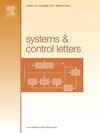Input fluctuation mitigation in coupled nonlinear control systems: A dual-mode DMPC approach
IF 2.5
3区 计算机科学
Q3 AUTOMATION & CONTROL SYSTEMS
引用次数: 0
Abstract
Excessive fluctuations in control inputs can severely compromise the performance, stability, and safety of control systems, posing significant challenges in various practical applications. This study introduces a novel dual-mode distributed model predictive control (DMPC) approach for a class of dynamically coupled nonlinear systems, aiming to effectively mitigate input fluctuations. The existence of a terminal invariant region (TIR) and its corresponding terminal stabilizing controller (TSC) is rigorously established for a globally coupled nonlinear system subject to input amplitude and fluctuation constraints. When the system state resides within the global TIR, the global TSC ensures consistent satisfaction of input amplitude and fluctuation constraints. When operating outside the global TIR, a set of parallel model predictive controllers with input amplitude and fluctuation constraints is developed, where an aperiodic event-triggering scheduler is introduced to reduce the likelihood of input fluctuation constraint violations during practical numerical implementation. The recursive feasibility and closed-loop stability of the proposed dual-mode DMPC approach are rigorously analyzed. Simulation results on coupled oscillators demonstrate its effectiveness in input fluctuation mitigation and system stabilization.
耦合非线性控制系统的输入波动抑制:一种双模DMPC方法
控制输入的过度波动会严重影响控制系统的性能、稳定性和安全性,在各种实际应用中构成重大挑战。针对一类动态耦合非线性系统,提出了一种新的双模分布式模型预测控制(DMPC)方法,以有效地缓解输入波动。对于受输入幅值和波动约束的全局耦合非线性系统,严格建立了末端不变量区域(TIR)的存在性及其对应的末端稳定控制器(TSC)。当系统状态处于全局TIR内时,全局TSC保证了输入幅值约束和波动约束的一致性满足。在全局TIR之外运行时,开发了一组具有输入幅度和波动约束的并行模型预测控制器,其中引入了非周期事件触发调度程序,以减少实际数值实现过程中输入波动约束违反的可能性。严格分析了所提出的双模DMPC方法的递归可行性和闭环稳定性。耦合振荡器的仿真结果证明了该方法在抑制输入波动和稳定系统方面的有效性。
本文章由计算机程序翻译,如有差异,请以英文原文为准。
求助全文
约1分钟内获得全文
求助全文
来源期刊

Systems & Control Letters
工程技术-运筹学与管理科学
CiteScore
4.60
自引率
3.80%
发文量
144
审稿时长
6 months
期刊介绍:
Founded in 1981 by two of the pre-eminent control theorists, Roger Brockett and Jan Willems, Systems & Control Letters is one of the leading journals in the field of control theory. The aim of the journal is to allow dissemination of relatively concise but highly original contributions whose high initial quality enables a relatively rapid review process. All aspects of the fields of systems and control are covered, especially mathematically-oriented and theoretical papers that have a clear relevance to engineering, physical and biological sciences, and even economics. Application-oriented papers with sophisticated and rigorous mathematical elements are also welcome.
 求助内容:
求助内容: 应助结果提醒方式:
应助结果提醒方式:


